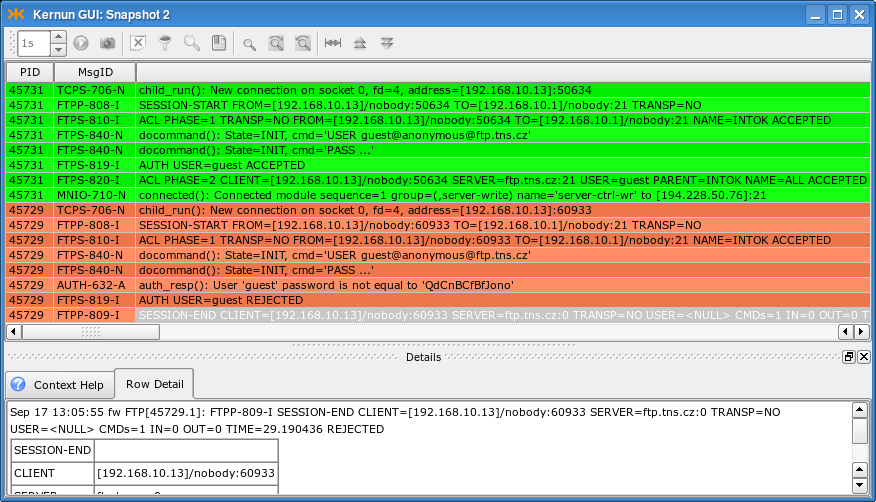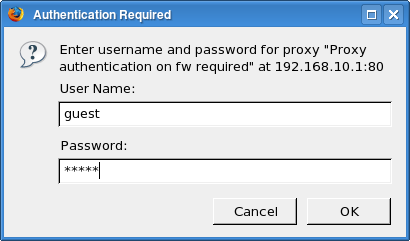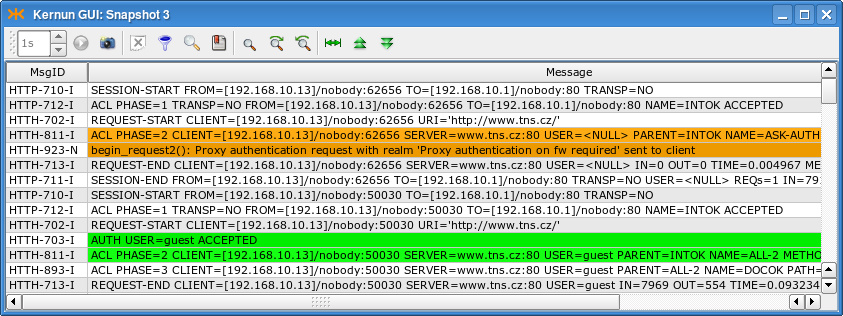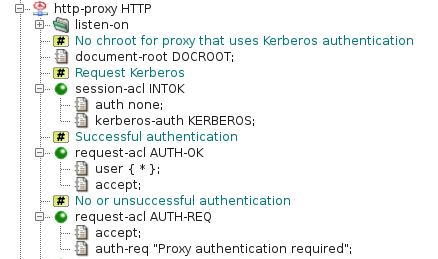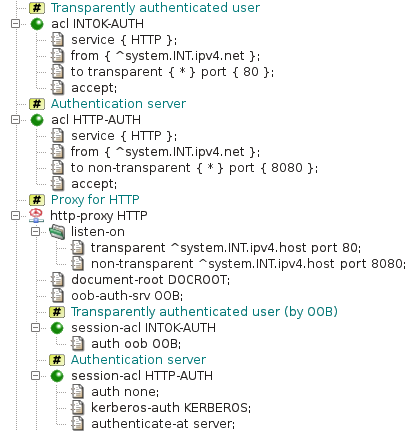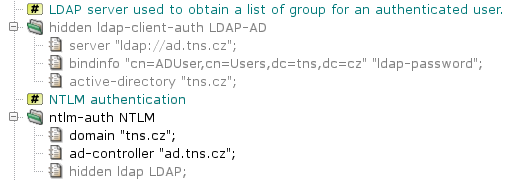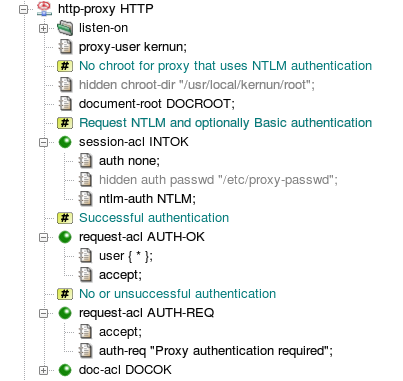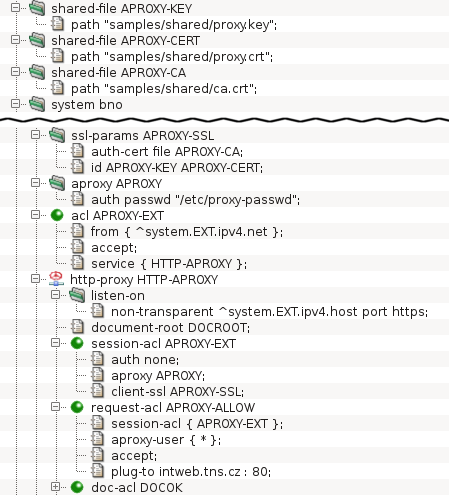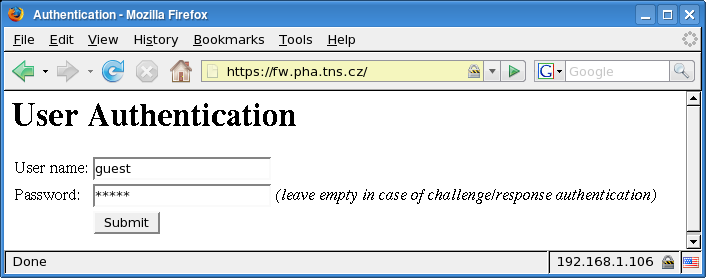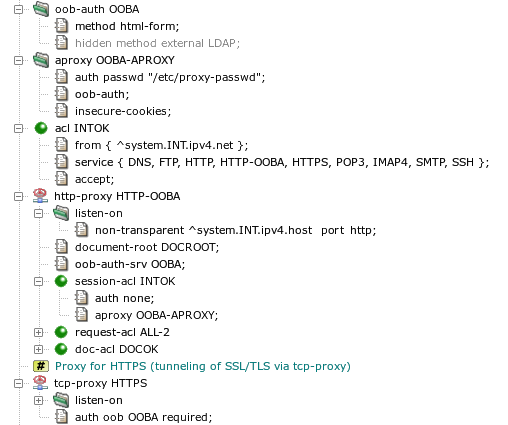Kernun UTM applies different rules to network traffic depending on the identity of the communicating parties. A client or a server can be identified in several ways. The basic one is the IP address and the port number, which are available for any network connection. The IP-based identity is used very often, but it distinguishes between computers, not users. Sometimes it is necessary to apply different rules to different users, while each user can work on several machines and each machine can be utilized by more than one user. In such situations, we need to identify individual users, independently on the IP addresses of the computers they use. Kernun UTM provides various means of user authentication. An authenticated user name can be used as one of the conditions tested when searching for an applicable ACL.
Some application protocols allow the passing of user credentials to a proxy within the normal protocol data flow. In Kernun UTM, such type of authentication is supported by the HTTP and FTP proxies. Many other proxies are able to use out-of-band (OOB) authentication, which binds a user name to a client machine IP address. Kernun UTM also provides a special authentication mode usable for protecting access to protected HTTP servers from clients in the external network—the HTTP authentication proxy.
Examples of configuration for all variants of authentication except NTLM
described
in this section are summarized in the sample configuration file
/usr/local/kernun/conf/samples/cml/auth.cml.
Kernun UTM supports several methods, described in detail in
auth(7). Section
ftp-proxy FTP in Figure 5.40, “Authentication methods”
contains sample auth items for different authentication
methods. To switch to another authentication method, simply hide
the single not hidden auth item and unhide another one.
- None
No user authentication is performed.
- Password file
The user provides a user name and a password, which are compared to name-password pairs in a password file stored locally on Kernun UTM. The administrator must create—by utility fwpasswd(1)—a file containing valid user names with encrypted passwords (
/etc/proxy-passwdin the example configuration).- RADIUS
The user name and password are verified by a RADIUS server. There are two variants: name/password (the user enters his name and the password) and challenge/response (the user enters her name, the RADIUS server generates a challenge, and the user replies by a response derived from the challenge and some secret information, e.g., using an authentication token hardware). If the
radiusmethod is chosen in anauthitem, it must reference aradius-clientsection that defines the parameters needed to connect to a RADIUS server.- LDAP
The user name and password are verified in an LDAP database. If the
ldapmethod is chosen in anauthitem, it must reference anldap-client-authsection that defines the parameters needed to connect to an LDAP server. If a secure connection to the LDAP server is used (the LDAP server URI begins withldaps), the certificates to be used must be specified in theldap-client-auth.sslsubsection.- Kerberos
The Kerberos authentication is specific to the http-proxy. If a user is authenticated in an Active Directory domain (or has a Kerberos TGT), a Web browser uses the user's Kerberos tickets and does not require any interaction with the user (name and password entry).
- NTLM
The NTLM authentication is specific to the http-proxy and HTTP clients (Web browsers) running on Microsoft Windows client operating systems. If a user is authenticated in an Active Directory domain, a Web browser uses the user's credentials known by the system since the login time and does not require any interaction with the user (name and password entry). It can be combined with other authentication methods for clients that do not support NTLM.
Note
If a proxy runs in chroot, the paths in
auth passwd and ldap-client-auth.ssl
are interpreted in the context of the chroot directory.
User authentication in the FTP proxy can be enabled using the
auth item that specifies an authentication method other than
none in session-acl. For example, a
proxy with the configuration shown in Section 14.1, “Authentication Methods” will
use a local password file. If authentication is enabled and the user does
not provide valid credentials, the proxy terminates the session.
Otherwise, it is possible to match user name or group using a
user item of command-acl. There are several
ways of sending authentication data to the proxy, see
ftp-proxy(8). An example FTP session initiation
with authentication, using a command line FTP client:
$ftp fw.pha.tns.czConnected to ftp.tns.cz. 220-fw.pha.tns.cz KERNUN FTP Proxy (Version KERNUN-3_0-RELEASE) Ready. Target server name/address and authentication to proxy required. You can use loginname in form of proxy_user@server_user@server. 220 Log in with USER and PASS command.Name (192.168.10.1:user):guest@anonymous@ftp.tns.cz331-USER command successful. Proxy user: 'guest'. Target-server user: 'anonymous'. Target server: ftp.tns.cz, port: 21. Enter password in form proxy_user_password@server_user_password. 331 Enter password or response, please.Password:****@****230-User 'guest' succesfully authenticated. 230-pha.tns.cz KERNUN FTP Proxy (Version KERNUN-3_0-RELEASE) Ready. 230-Welcome to ftp.tns.cz FTP service. 230----- proxy connected to [194.228.50.76]/ftp.tns.cz port 21 ---- ---- proxy connected to ftp.tns.cz port 21 ---- 230-Please specify the password. 230 Login successful. Remote system type is UNIX. Using binary mode to transfer files.ftp>
A similar, but unsuccessful session initiation (due to a wrong password):
$ftp fw.pha.tns.czConnected to ftp.tns.cz. 220-fw.pha.tns.cz KERNUN FTP Proxy (Version KERNUN-3_0-RELEASE) Ready. Target server name/address and authentication to proxy required. You can use loginname in form of proxy_user@server_user@server. 220 Log in with USER and PASS command.Name (192.168.10.1:user):guest@anonymous@ftp.tns.cz331-USER command successful. Proxy user: 'guest'. Target-server user: 'anonymous'. Target server: ftp.tns.cz, port: 21. Enter password in form proxy_user_password@server_user_password. 331 Enter password or response, please.Password:****@****421 User 'guest' not authenticated. ftp: Login failed.ftp>
Selected log messages related to these two FTP sessions are displayed in Figure 5.41, “Log of authentication in FTP proxy”.
The HTTP proxy supports proxy authentication using the Basic authentication method, i.e., a name and a password entered by the user. The technical details of the authentication are described in http-proxy(8). Proxy authentication in HTTP works as follows: the first request sent by the client (browser) is unauthenticated, the proxy replies with response code 407 “Proxy Authentication Required”; upon reception of this response code, the browser displays a dialog (see Figure 5.42, “Proxy authentication dialog in a Web browser”) asking for user credentials; the browser then repeats the request with the user name and password attached.
Figure 5.43, “User authentication configuration in the HTTP proxy” contains an HTTP proxy
configuration with user authentication. The authentication is enabled and
the authentication method (a password file in this case) is selected by the
auth item in session-acl. If a request
contains user credentials, they are checked and if correct, the
user name—and the list of groups the user belongs to—is
remembered for matching with the user item in a
request-acl. Unlike in the case of FTP proxy, a request
containing invalid or no credentials is not rejected. The processing
continues, but no request-acl containing a
user item matches, except for the one with
user none. There should be a
request-acl that matches unauthenticated requests and
returns the 407 response. In the example configuration, there are two
request-acl sections. The first one,
request-acl ALL-2, matches any successfully
authenticated user. The request is processed normally, i.e., forwarded to
the target server. The other, request-acl ASK-AUTH,
matches if the request does not contain valid user credentials[30]. The 407 response is
forced by the auth-req item. This item also sets the
realm (prompt) that is usually displayed by the
browser in the authentication dialog, as depicted in Figure 5.42, “Proxy authentication dialog in a Web browser”.
If we apply this sample configuration to Kernun UTM and invoke
a new request in a Web browser, the log will contain messages similar to
those in Figure 5.44, “Log of user authentication in the HTTP proxy”. The first request was
unauthenticated. The two orange messages inform us that
request-acl ASK-AUTH was selected and response 407
was returned to the browser. After the user filled in the authentication
dialog, the request was repeated. The user name and password were correct,
user guest was authenticated
successfully, and request-acl ALL-2 was selected,
as indicated by the two green messages.
Important
Because many Web browsers do not expect to be required to perform proxy authentication when no HTTP proxy is configured in the browser, proxy authentication may not work with a transparent proxy. It is possible in such a case that users are displayed a 407 error page instead of the authentication dialog. Use proxy user authentication with a non-transparent HTTP proxy only, unless you check that Web browsers on your client machines handle it correctly with a transparent HTTP proxy.
The Kerberos authentication is an alternative to the Basic authentication described in Section 14.3, “Basic Authentication in HTTP Proxy”. It provides a single-sign-on capability for clients authenticated in an Active Directory domain or a Kerberos realm. If a user is logged in a domain, or has a valid Kerberos ticket, a Kerberos-capable Web browser can authenticate the user to the proxy automatically, without asking the user for a name and a password.
Kerberos authentication in Active Directory is supported for Microsoft Windows server and Samba 4 acting as an Active Directory domain controller. Older Samba versions (3.x) cannot be configured as an AD domain controller.
Warning
Authentication to a Samba server uses different
authentication mechanism than a MS Windows Server by default. This
authentication mechanism (GSS-SPNEGO) fails and may allocate all available
memory. Hence, the client (Kernun http-proxy) should be
configured to use GSSAPI instead. This can be done by adding file
.ldaprc to the root directory and to home directories
of users involved in authentication (root and kernun). The file should contain line:
SASL_MECH GSSAPI
Important
If an HTTP proxy uses the Kerberos authentication, it cannot be run chrooted, because it needs access to some system components that are not contained in the standard Kernun chroot environment.
An example of a Kerberos configuration is stored in the sample
configuration file
/usr/local/kernun/conf/samples/cml/kerberos-auth.cml.
The system section contains global configuration related
to the Kerberos authentication in section kerberos-auth,
Figure 5.45, “Kerberos authentication — section
system”. Two parameters are required:
the name of the Active Directory domain (or Kerberos realm)
domain and the address of the domain controller (or the
Kerberos KDC) ad-controller. The Kerberos authentication
itself provides the name of an authenticated user to the proxy.
A request-acl can be selected according to the user name
or group membership. For the latter option, the proxy needs to know the
list of groups the user belongs to. The list can be obtained from an LDAP
server. As the Active Directory contains all the necessary information and
provides LDAP interface, the Active Directory controller is usually used
as the LDAP server. Obtaining group membership can be configured by
unhiding the hidden item ldap and section
ldap-client-auth in the sample configuration in Figure 5.45, “Kerberos authentication — section
system”. The URL of the LDAP server references
the Active Directory controller. The proxy authenticates itself to the
LDAP server by Kerberos using the machine account of the Kernun system in
the Active Directory. The Kerberos authentication for LDAP is enabled by
ldap-client-auth.kerberos. Alternatively, the proxy can
authenticate itself using a name and a password of a user with the
permission to access the Active Directory contents for reading. The user's
credentials must be specified in the bindinfo item in
place of ADUserldap-passwordactive-directory, which also specifies the domain name.
Important
The Active Directory domain name must be written using UPPERCASE LETTERS in the configuration.
Warning
A user's primary group name (usually Domain Users) is neither logged nor
matched by request-acl.user.group.
The Kerberos configuration can be enabled in an HTTP proxy by item
session-acl.kerberos-auth. Outcome of the Kerberos
authentication is processed like the Basic authentication. The user name,
optional list of groups, or the fact that the authentication failed, can
be used as conditions in request-acl sections. There is
usually one or more request ACLs that permit access to successfully
authenticated users and one request ACL that denies access to
unauthenticated users and asks for authentication. The sample
configuration in Figure 5.46, “Kerberos authentication — section
http-proxy” allows
access to any authenticated user
(request-acl AUTH-OK). Users that are not
authenticated are requested to perform authentication by
request-acl AUTH-REQ.
In the Kerberos and LDAP configurations presented so far, user and
group names are matched in ACLs and written to logs in a short form,
without information about domains they belongs to. This may not be
sufficient in a multi-domain environment, where different domains may
contain users and groups with the same names. Such a multi-domain
environment can comprise either domains in a single Active Directory
forest, or even domains from several forests if there are explicit trusts
between forests[31]. Configuration item
kerberos-auth.user-match full switches to using long
user name in logs and ACLs in format
“user@REALM” instead of the default short
format “user”. Likewise, adding value
“group-match domain” to item
ldap-client-auth.active-directory enables using long
group names “group@domain”.
The LDAP server on each Active Directory controller returns only
data from its own domain. Hence, group membership of a user must be
queried in the domain which the user belongs to. The proxy is able to
select the LDAP server according to the domain name of the authenticated
user. To do this, there must be an ldap-client-auth
section for each domain. Section kerberos-auth must
contain item ldap domain, instead of naming a single
ldap-client-auth section. Then the
ldap-client-auth section will be selected by its Active
Directory domain name (specified in item
active-directory).
Information about membership of Kerberos-authenticated users in
groups can be cached in order to decrease load of LDAP servers.
Configuration of caching consists of adding the global section
oob-auth OOB and referencing it by item
http-proxy.oob-auth-srv. Cached group membership
information for a user name expires after a timeout controlled by items
kerberos-auth.timeout-idle (expiration after a period of
inactivity) and kerberos-auth.timeout-unauth
(unconditional expiration).
The Kerberos authentication requires some initialization steps before in order to start working. There are two supported methods of initialization.
Important
In order to work correctly, Kerberos authentication requires several conditions to be fulfilled:
The Kernun system and the Active Directory domain controller must have their system time synchronized. By default, maximum allowable clock difference is 5 min. It is possible to synchronize Kernun system's clock to the Active Directory time by configuring the domain controller as an NTP server in the Kernun configuration.
The Kernun system must resolve the domain name of the Active Directory domain controller to the correct IP address. The reverse resolution of this IP address must also work and yield the original domain name used for the forward resolution as the first name of the response.
The first method adds the Kernun system to the Active Directory
domain by deleting its machine account if it already exists and creating
a new machine account. Then it sets up the Kerberos keytab with all keys
necessary for authentication and obtaining group membership information.
A user account userDomain Admins rights is required for
this task. The initialization process is performed by issuing shell
commands on the Kernun system:
#kinituser#ldapdelete -v -H ldap://ADCcn=COMPUTER,cn=Computers,dc=D1,dc=D2...#msktutil -c --computer-name `hostname -s` -s HTTP/`hostname` \ -h `hostname` --serverADC--no-pac#chown kernun /etc/krb5.keytab
where ADCD1, D2, ...example.com, we use
dc=example,dc=com). The computer account name COMPUTER--computer-name with appended character
'$'. If the default computer account name
`hostname -s` is used, a command for automatic
password renewal (msktutil --auto-update) will be
added to /etc/crontab. It is possible to choose
another computer account name. A non-default name must be configured in
the http-proxy by setting
kerberos-auth.kinit to
". In this case,
the machine account password renewal must be handled manually, or (better)
password expiration must be turned off for the account by option
computername$"--dont-expire-password of msktutil.
Important
The computer account name must be entered to the
configuration with the appended character '$'.
Example: The initialization commands will be, for the domain
administrator admin, the Active
Directory domain EXAMPLE.COM,
the domain controller ad.example.com, and the Kernun system
kernun.example.com:
#kinit admin#ldapdelete -v -H ldap://ad.example.com \ 'cn=kernun$,cn=Computers,dc=example,dc=com'#msktutil -c --computer-name `hostname -s` -s HTTP/`hostname` \ -h `hostname` --server ad.example.com --no-pac#chown kernun /etc/krb5.keytab
If clients should access the proxy via a name different from the
fully qualified host name of the Kernun system, that name must be
specified in the -s argument of the
msktutil command. The same name must be configured in
kerberos-auth.proxy-host or
session-acl.kerberos-auth.
Instead of saving the created keytab into the default location
/etc/krb5.keytab, another file name can by set by
adding option
-k to the
msktutil command line. The custom keytab location must
be configured as a keytab_fileshared-file referenced from
kerberos-auth.keytab.
If the system is to be removed from the domain later (when Kerberos
authentication is no more required or if the system will be moved to
another domain), remove file /etc/krb5.keytab and
delete the machine account on the Active Directory Controller.
The second method of Kerberos initialization comprises generating a keytab on the Active Directory controller, transferring the keytab to the Kernun system, and configuring Kernun to use the keytab. The initialization procedure consists of several steps:
Create a user account in the Active Directory. The account must be configured so that its password never expires and it must have enough rigths to read user and group information from the Active Directory (usually, membership in the
Domain Usersgroup suffices).Generate the keytab using the command line on the domain controller:
C:\>ktpass /outKEYTAB/princ HTTP/PROXY@AD_DOMAIN/mapuserUSER@AD_DOMAIN/pass * /crypto All /ptype KRB5_NT_PRINCIPALwhere the parameters are:
KEYTABThe file name for the created keytab file.
PROXYThe proxy name used by clients. If it it not the fully qualified host name of the Kernun system, the name must be configured in
kerberos-auth.proxy-hostorsession-acl.kerberos-auth.AD_DOMAINThe Active Directory domain name, in upper case.
USERThe name of the user created in step 1. The command will request entering this user's password. Alternatively, the password may be specified on the command line by
/passinstead ofPASSWD/para *.
Copy the keytab to the Kernun system or to the computer running Kernun GUI.
Configure the keytab as a
shared-fileand add a reference to this shared file intokerberos-auth.keytab. The keytab shared-file should be stored in a location included in backup and upgrade, for example,/usr/local/kernun/conf.Set
kerberos-auth.kinitto the proxy principal nameHTTP/.PROXY
Example: The keytab creation command will be, for the Kernun user
account kernun, the Active
Directory domain EXAMPLE.COM,
the Kernun system kernun.example.com, and the output keytab
file krb5.keytab:
C:\>ktpass /out krb5.keytab /princ HTTP/kernun.example.com@EXAMPLE.COM /mapuser kernun@EXAMPLE.COM /pass * /crypto All /ptype KRB5_NT_PRINCIPAL
Note
Configuring a keytab as a shared file makes easy distribution of the keytab to cluster nodes.
If Kerberos authentication is no more required, remove the keytab from the Kernun system and delete the user account from the Active Directory controller.
As was already mentioned, web browsers usually refuse proxy authentication on a transparent HTTP proxy. This problem can be solved by redirecting an unauthenticated transparent HTTP request to an authentication server. The server performs authentication, remembers the association of an IP address to a user name in the out-of-band authentication table, and redirects the request back to the origin server. As the Kerberos authentication is done in the background, it is invisible to the user.
An example of a Kerberos transparent proxy configuration is stored in
the sample configuration file
/usr/local/kernun/conf/samples/cml/kerberos-auth-transp.cml.
The proxy must be configured as an OOB authentication server by
adding the oob-auth global configuration section and
referencing it by item http-proxy.oob-auth-srv. Kerberos
and optional LDAP configuration is like in the non-transparent case, see
Figure 5.45, “Kerberos authentication — section
system”.
The HTTP proxy configuration is shown in Figure 5.47, “Transparent Kerberos authentication — session ACLs” and Figure 5.48, “Transparent Kerberos authentication — request ACLs”. Global
acl INTOK-AUTH and the corresponding
session-acl INTOK-AUTH handle transparent requests to
origin servers. These requests are authenticated using out-of-band
authentication. Authenticated users are passed by
request-acl HTTP-OK. If a user is not authenticated,
the request will be redirected to the authentication server by
request-acl HTTP-RDR. Redirected requests are handled
by global acl HTTP-AUTH and the corresponding
session-acl HTTP-AUTH. The client is asked for
Kerberos authentication by request-acl AUTH-REQ.
Authentication is performed by the browser without asking the user for
a name or a password. Then request-acl AUTH-OK stores
the IP address of the successfully authenticated user into the out-of-band
table and redirects the browser to the originally requested URI. Further
requests use OOB authentication and are handled without redirection to the
authentication server.
Important
In Firefox, Kerberos authentication must be explicitly
enabled for each server, in our example fw.pha.tns.cz. It can be done by typing
a special uri about:config into the address line to show
advanced settings, and then setting the server name to option
network.negotiate-auth.trusted-uris.
Important
Internet Explorer, Chrome and Opera users may be prompted for a password to authenticate to the authentication server. To avoid it they must configure the browser for automatic logon. To do this
Go to the
Internet Optionsdialog box, on theSecuritytab selectLocal intranet, and then clickCustom Level.In the
Security Settingsdialog box, underLogon, selectAutomatic logononly inIntranet zone, and then clickOK.In the
Internet Optionsdialog box on theSecurity Settingstab withLocal intranetstill selected, clickSites.In the
Local intranetdialog box, clickAdvanced.In the next dialog box (also titled
Local intranet), type the URL of the authentication server http://fw.pha.tns.cz:8080/ in theAdd this Web site to the zone box, and then clickAdd.
The NTLM authentication is an alternative to the Basic authentication described in Section 14.3, “Basic Authentication in HTTP Proxy”. It provides a single-sign-on capability for Microsoft Windows clients authenticated in an Active Directory domain. If a user is logged in a domain, an NTLM-capable Web browser can authenticate the user to the proxy automatically, without asking the user for a name and a password. The NTLM authentication can be used instead of the Basic authentication, or both authentication methods can be used together. In an NTLM-only configuration, clients incapable of the NTLM authentication cannot authenticate. In a configuration with both authentication methods, an NTLM-capable client uses NTLM and other clients use Basic.
Important
If an HTTP proxy uses the NTLM authentication, it cannot be run chrooted, because it needs access to some system components that are not contained in the standard Kernun chroot environment.
Important
The DNS domain name of the Active Directory controller
must correspond to the Active Directory domain name. For example, a domain
controller for the domain tns.cz
should be named like ad.tns.cz.
An example of an NTLM configuration is stored in the sample
configuration file
/usr/local/kernun/conf/samples/cml/ntlm-auth.cml.
The system section contains global configuration related to
the NTLM authentication in section ntlm-auth, see Figure 5.49, “NTLM authentication — section
system”. Two
parameters are required: the name of the Active Directory domain
(domain) and the address of the domain controller
(ad-controller). The NTLM authentication itself provides
the name of an authenticated user to the proxy.
A request-acl can be selected according to the user name
or group membership. For the latter option, the proxy needs to know the
list of groups the user belongs to. The list can be obtained from an LDAP
server. As the Active Directory contains all the necessary information and
provides LDAP interface, the Active Directory controller is usually used
as the LDAP server. Obtaining group membership can be configured by
unhiding the hidden item ldap and section
ldap-client-auth in the sample configuration in Figure 5.49, “NTLM authentication — section
system”. The URL of the LDAP server references
the Active Directory controller. A user with the permission to access the
Active Directory contents for reading must be specified in the
bindinfo item in place of ADUserldap-passwordactive-directory, which also specifies the domain name.
The NTLM configuration can be enabled in an HTTP proxy by item
session-acl.ntlm-auth. Outcome of the NTLM authentication
is processed like the Basic authentication. The user name, optional list
of groups, or the fact that the authentication failed, can be used as
conditions in request-acl sections. There is usually one
or more request ACLs that permit access to successfully authenticated
users and one request ACL that denies access to unauthenticated users and
asks for authentication. The sample configuration in Figure 5.50, “NTLM authentication — section
http-proxy” allows access to any authenticated
user (request-acl AUTH-OK). Users that are not
authenticated are requested to perform authentication by
request-acl AUTH-REQ.
Administrators often want to enable the more user-friendly NTLM
authentication and to provide an alternative for clients that are not
capable of the NTLM authentication. Such a configuration can be created by
setting both items ntlm-auth and
auth in the same session-acl, for
example, by unhiding the line
“hidden auth passwd ...” in
Figure 5.50, “NTLM authentication — section
http-proxy”. The proxy will offer both NTLM
and Basic authentication schemes. The client can choose any of
them[32].
After the NTLM authentication is configured and the configuration
applied to a Kernun system, it is necessary to add the Kernun system to
the Active Directory domain. A user account
userDomain Admins rights is
required for this task. The Kernun system is added to the domain by the
shell command
#net ads join -Uuser
The system should then be rebooted in order to initialize and start the system components that provide an interface between the proxy and the Active Directory controller[33]. If the NTLM authentication is no more required, or if the Active Directory domain or the domain controller changes, the system should be removed from the domain by the shell command
#net ads leave -Uuser
It can be later added to another domain by
net ads join.
Membership of a Kernun system in an Active Directory domain can be tested
by the shell command wbinfo -t. If the system
has been successfully added to a domain, we get:
#wbinfo -t; echo $?checking the trust secret via RPC calls succeeded 0
Otherwise, the output is:
#wbinfo -t; echo $?checking the trust secret via RPC calls failed error code was NT_STATUS_NO_TRUST_SAM_ACCOUNT (0xc000018b) Could not check secret 1
Results of NTLM authentication can be cached by out-of-band authentication (see also Section 14.8, “Out of Band Authentication”), in order to decrease load of Active Directory and LDAP servers. Each new client is authenticated by NTLM. The combination of the client IP address, the user name and the list of groups is remembered in the OOB session table. Following requests from the same IP address will be authenticated as the same user and groups, without contacting the AD controller and the LDAP server. Computer accounts (i.e. users whose name ends with a dollar) are not added to the OOB session table.
Configuration of NTLM caching consists of adding the global section
oob-auth OOB, referencing it by item
http-proxy.oob-auth-srv, and adding item
auth oob OOB to each
session-acl that contains item
ntlm-auth. Cached user and group information for a client
IP address expires after a timeout controlled by items
ntlm-auth.timeout-idle (expiration after a period of
inactivity) and ntlm-auth.timeout-unauth (unconditional
expiration).
Tip
The preferred authentication method in Active Directory environment is Kerberos, see Section 14.4, “Kerberos Authentication in HTTP Proxy”.
The HTTP proxy can be used to control access to a Web server in the protected network[34] from clients in the external network. A typical situation is a Web interface to a corporate mail server accessed by employees from machines in the Internet, for example from their homes. In such a case, the security policy often requires the use of sessions with limited lifetime authenticated by a strong mechanism, such as a challenge-response protocol that utilizes one-time passwords generated by hardware authentication tokens. Also, as we mentioned in Section 14.3, “Basic Authentication in HTTP Proxy”, HTTP proxy authentication does not often work if the proxy is not configured in the browser explicitly. For such situations, there is a special operation mode of the HTTP proxy, called the HTTP authentication proxy, or AProxy for short.
A typical AProxy configuration is displayed in Figure 5.51, “Configuration of the HTTP authentication proxy”. It is a configuration for access from
clients in the Internet to the server intweb.tns.cz in the internal
network. As the Internet is an untrusted network, the connections from
clients are secured by TLS, which is enabled by the
ssl-params APROXY-SSL section and the
client-ssl
item in session-acl APROXY-EXT. The internal network is
considered secure, therefore plain unencrypted HTTP is used. (For
detailed explanation of SSL/TLS in Kernun UTM, see Section 13, “Secure Communication Using SSL/TLS”.)
The configuration section aproxy APROXY defines
various parameters of the AProxy. The example contains only the
auth item, which defines that the AProxy will verify user
credentials against a local password file. The default maximum session
time after a successful authentication is one hour. After that time, the
user is logged out and must authenticate again. Also, if the session is
idle—the client does not issue any request—for more than
5 minutes, the user must reauthenticate. These default timeout values
can be changed by items timeout-unauth and
timeout-idle of section aproxy.
Further configurable AProxy parameters are described in
http-proxy(5).
The AProxy mode is activated by the aproxy item of
a session-acl. The user name obtained during AProxy
authentication can be used to select a request-acl, by
matching an aproxy-user item. In the sample
configuration, a client accesses the AProxy by connecting to the
external IP address of Kernun UTM. If authentication succeeds, the HTTP
requests from the client are passed to the internal server defined by
plug-to.
Warning
An AProxy session cookie is a sensitive piece of
information and should be kept secret, because an attacker could use it to
steal the identity of an authenticated user. Hence, the AProxy is usually
configured so that the connections between clients and the proxy are
secured by SSL/TLS (see Section 13, “Secure Communication Using SSL/TLS”). It is possible to
operate the AProxy using plain HTTP by enabling
aproxy.insecure-cookies and not configuring
client-ssl on the client side of the proxy, but it is
strongly recommended not to so unless the clients are connected
to Kernun UTM via a trusted network.
A user starts by entering an AProxy URL to a Web browser. The AProxy returns an authentication dialog, as displayed in Figure 5.52, “The user authentication dialog of the HTTP authentication proxy”. The user fills in their login name and password and clicks . If a challenge-response authentication protocol is used[35], the user must fill in the login name only. The AProxy then displays a challenge and the user enters the response (obtained, e.g., from a hardware authentication token). If the authentication succeeds, a new session is initiated and the AProxy forwards the original HTTP request to the destination server. Further requests do not require reauthentication and are transparently passed to the server. The user must authenticate again only if the session expires because of a timeout. It is also possible to log out and terminate the session explicitly by accessing a special logout URL, as shown in Figure 5.53, “The logout confirmation message of the HTTP authentication proxy”.
The HTML authentication forms displayed by the AProxy are very
simple, but their appearance is easy to modify. Form templates
are stored in the
/usr/local/kernun/conf/samples/error_documents directory.
The template files are: aproxy-password-form.html
(the form with user name and password fields),
aproxy-password-form.html (the form with a response
field for challenge-response authentication), and
aproxy-logout.html (the logout message).
Important
The AProxy uses cookies to track sessions. The cookies are added to HTTP response messages by the proxy, but they appear to the client as coming from the server. The session cookies are then extracted by the proxy from the requests. As a cookie received from a server is never sent to other servers, it is impractical to use the AProxy for authentication of clients in the internal network accessing Web servers in the Internet.
Many application protocols do not support user authentication on a proxy. Even in protocols with a proxy authentication mechanism it may be undesirable to use it in some situations. Nevertheless, we may still want to perform access control and network usage monitoring for individual users. The out-of-band authentication (OOBA) provides a solution in such cases. It is based on the fact that for any network protocol, the proxy knows the IP address of the client machine. The OOBA simply binds user names with IP addresses. There is an OOBA server, which maintains a table containing pairs of user names and IP addresses. When a proxy accepts a new network connection, it sends the client IP address to the authentication server and receives the corresponding user name or the information that no user is authenticated from that IP address. As is the case with other authentication methods, the user name can be used as a condition for ACL selection.
Note
As the out-of-band authentication cannot distinguish connections from a single IP address, more than one user cannot be authenticated on a single client machine at the same time. For this reason, computer accounts (i.e. users whose name ends with a dollar) are not automatically added to the OOB session table. On the other hand, one user can be authenticated on many machines simultaneously.
A sample configuration of the OOB authentication is displayed in
Figure 5.54, “Configuration of the out-of-band authentication”, with
http-proxy HTTP-OOBA serving as the OOB
authentication server, and tcp-proxy HTTPS, which
allows access only to users authenticated by the OOBA. The
oob-auth OOBA section
defines parameters of the OOB authentication. Only the authentication
method is specified in this example. See
auth(5) for description of all available
parameters. This session is referenced in
http-proxy HTTP-OOBA by the
oob-auth-srv item. The HTTP proxy is switched to the OOBA
mode by adding the oob-auth item to an aproxy
section and referencing this section by a session-acl.
In the sample configuration, a password file is used to check user names
and passwords. As the OOBA is performed in the internal network, which is
assumed to be secure, plain HTTP without SSL/TLS is used, which is why
insecure-cookies needs to be added to the
aproxy section.
The html-form OOB authentication method is selected in
the sample configuration. It authenticates users interactively in the
same way as the AProxy (Section 14.7, “HTTP Authentication Proxy”). The alternative
option, external (marked as
hidden in the sample configuration),
is to import the list of authenticated users from a server in the
network. The external OOBA is fully transparent. Users do not have to do
anything special, they just log in to the server that provides data to the
Kernun UTM OOB authentication server. Out of the box, Kernun UTM contains the
ooba-samba(1) script, which implements integration
with Samba.
The tcp-proxy HTTPS proxy uses the OOB
authentication and accepts authenticated users only. The
OOBA is activated by setting the oob method in the
auth item. The OOBA server and proxies that provide OOBA
communicate via a session table file. Therefore, they must all reference
the same file in the oob-auth sessions they use. If no
file is specified, as in our example, a common default file will be
used. The authenticated user name could be matched by
a session-acl. Another way to reject
unauthenticated users without creating a denying ACL for them is to add
the required parameter to the auth item. It
causes immediate termination of sessions initiated by unauthenticated
users, even before ACL matching begins.
When the html-form OOBA method is used, a user must
access the authentication page (Figure 5.52, “The user authentication dialog of the HTTP authentication
proxy”) by
opening the OOBA server URL in a Web
browser. After entering a valid name and password, a login confirmation
page is displayed, see Figure 5.55, “Login to the OOB authentication server”. It contains
a link that can be used to log the user out. Like in the case of AProxy,
the authentication pages displayed by the OOB authentication server can be
changed by modifying template files in
/usr/local/kernun/conf/samples/error_documents.
There are two more OOBA authentication forms, ooba-login-confirm.html
(login confirmation) and ooba-logout-confirm.html
(logout confirmation), in addition to the AProxy ones, which are reused.
[30] This happens in the case of the first request or a wrong name or password entered by the user.
[31] Trusts are needed because the Kernun system authenticates itself in only one Kerberos realm, but it must be able to accept authentication from other domains and also to authenticate itself to LDAP servers in other domains.
[32] The client should choose the strongest implemented authentication scheme, in this case NTLM.
[33] Kernun uses Samba for communication related to the NTLM authentication between a proxy and the Active Directory.
[34] usually in the internal network or in the demilitarized zone
[35] implemented only for authentication method RADIUS

